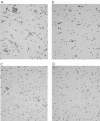Endocarditis with ruptured cerebral aneurysm caused by Cardiobacterium valvarum sp. nov
- PMID: 15071009
- PMCID: PMC387565
- DOI: 10.1128/JCM.42.4.1590-1595.2004
Endocarditis with ruptured cerebral aneurysm caused by Cardiobacterium valvarum sp. nov
Abstract
A fastidious gram-negative bacterium was isolated from the blood of a 37-year-old man who had insidious endocarditis with a sudden rupture of a cerebral aneurysm. Characterization of the organism through phylogenetic and phenotypic analyses revealed a novel species of Cardiobacterium, for which the name Cardiobacterium valvarum sp. nov. is proposed. C. valvarum will supplement the current sole species Cardiobacterium hominis, a known cause of endocarditis. Surgeries and antibiotic treatment cured the patient's infection and associated complications. During cardiac surgery, a congenital bicuspid aortic valve was found to be the predisposing factor for his endocarditis.
Figures


References
-
- American Type Culture Collection. 2004. Catalog. [Online.] American Type Culture Collection, Manassas, Va. http://www.atcc.org/SearchCatalogs.
-
- Clementi, M., L. Notari, A. Borghi, and R. Tenconi. 1996. Familial congenital bicuspid aortic valve: a disorder of uncertain inheritance. Am. J. Med. Genet. 62:336-338. - PubMed
-
- Dewhirst, F. E., B. J. Paster, S. La Fontaine, and J. I. Rood. 1990. Transfer of Kingella indologenes (Snell and Lapage 1976) to the genus Suttonella gen. nov. as Suttonella indologenes comb. nov.; transfer of Bacteroides nodosus (Beveridge 1941) to the genus Dichelobacter gen. nov. as Dichelobacter nodosus comb. nov.; and assignment of the genera Cardiobacterium, Dichelobacter, and Suttonella to Cardiobacteriaceae fam. nov. in the gamma division of Proteobacteria on the basis of 16S rRNA sequence comparisons. Int. J. Syst. Bacteriol. 40:426-433. - PubMed
-
- Dyson, C., R. A. Barnes, and G. A. Harrison. 1999. Infective endocarditis: an epidemiological review of 128 episodes. J. Infect. 38:87-93. - PubMed
Publication types
MeSH terms
Grants and funding
LinkOut - more resources
Full Text Sources
Medical
Molecular Biology Databases

